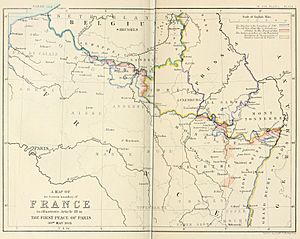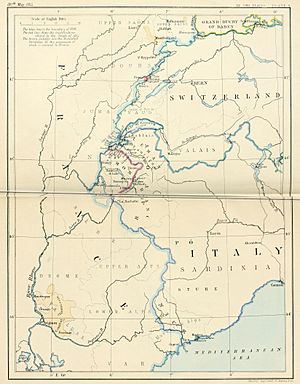Treaty of Paris (1814) facts for kids
The Treaty of Paris was a peace agreement signed on May 30, 1814. It officially ended the war between France and a group of countries called the Sixth Coalition. This war was part of the bigger Napoleonic Wars.
The treaty was signed after a ceasefire, or armistice, on April 23. This ceasefire was agreed upon by Charles, Count of Artois, who later became king of France, and the allied nations. The treaty set new borders for France under the Bourbon royal family. It also gave back land to other countries. Sometimes, people call it the First Peace of Paris because another treaty followed in 1815.
Contents
Who Signed the Treaty?
This important treaty was signed on May 30, 1814. It came after an armistice on April 23, 1814, between Charles, Count of Artois, and the allied powers. Just before this, Napoleon Bonaparte had given up his power as Emperor on April 13. This happened after talks at Fontainebleau.
Peace discussions began on May 9. Talleyrand represented the exiled Bourbon king, Louis XVIII of France. He talked with the allies who had formed the Sixth Coalition. The Treaty of Paris brought peace between France and several powerful nations. These included the United Kingdom of Great Britain and Ireland, Russia, Austria, and Prussia. These countries had agreed on their war goals in March at the Treaty of Chaumont.
Portugal and Sweden also signed the treaty. Spain signed it shortly after in July. The allied countries did not sign one big document together. Instead, each country made its own separate treaty with France. This allowed for specific changes for each nation.
France's New Borders
The allied nations wanted to make France smaller. They agreed to return France to its 1792 borders. They also wanted to make sure France's neighbors were independent again. This was after Napoleon Bonaparte was defeated.
Planning the Congress of Vienna
Besides ending the fighting, the treaty also outlined a plan for a final agreement. Article 32 of the treaty said this final agreement would be made within two months. It would happen at a big meeting called a congress. All countries involved in the Napoleonic Wars would attend. This meeting became known as the Congress of Vienna. It took place between September 1814 and June 1815.
The conditions for France in the Paris treaty were quite fair. This was done to help the new Bourbon king, Louis XVIII of France, settle back into power. France's borders from June 1, 1792, were confirmed. France also got to keep some extra areas. These included Saarbrücken, Saarlouis, Landau, and the County of Montbéliard. Parts of Savoy with Annecy and Chambéry were also kept. France also kept Avignon and the Comtat Venaissin. It even got to keep valuable art taken during the war. However, France had to give up some of its colonies.
To tell it apart from a second treaty of Paris in 1815, the May 30, 1814, agreement is often called the First Peace of Paris.
Territories of Other Nations
The treaty changed who controlled many territories. France kept all the land it had on January 1, 1792. This meant it got back many areas lost to Britain during the war. For example, France got back Guadeloupe (Article IX). Britain had given Guadeloupe to Sweden when Sweden joined the coalition. In return, Sweden received 24 million francs as payment. This money was called the Guadeloupe Fund.
However, France did not get back all its colonies. Tobago, St. Lucia, Seychelles, and Mauritius were all given to British control. Britain also kept control over the island of Malta (Article VII).
The treaty returned Santo Domingo to Spain (Article VIII). This land had been given to France in 1795 by the Peace of Basel. This also meant France still claimed control over Saint-Domingue. However, Dessalines had already declared Saint-Domingue independent as Haiti. France did not officially recognize Haiti's independence until 1824.
This treaty also formally recognized that Switzerland was an independent country (Article VI).
The Bourbon Monarchy
The treaty officially recognized the Bourbon royal family in France. This meant Louis XVIII was the rightful king. The treaty was signed between King Louis XVIII of France and the leaders of the powerful allied nations.
Slave Trade and Slavery
The treaty aimed to stop the French slave trade within five years. However, it did not aim to end slavery itself in France's territories.
What Happened Next?
Even with the peace treaty, some powerful countries still worried about France becoming too strong again. So, they made their own territories stronger for protection. For example, the Netherlands had been freed from French rule in 1813. They asked William I of the House of Orange to be their prince. He accepted this request in late 1813.
This was a step towards what happened in 1815 during the Congress of Vienna. It also happened around the time of Napoleon's "Hundred Days" return to power. In March 1815, the United Kingdom of the Netherlands was formed. This new country included the former Austrian Netherlands. William I became its king. His son, William, later fought at the Battle of Waterloo. This battle took place in the United Kingdom of the Netherlands. The powerful nations had secretly agreed to support a strong country on France's border. This was written in the Eight Articles of London, signed on June 21, 1814. So, the Dutch request to William I had strong support from the United Kingdom and other countries.
Many German states had been combined by Napoleon. They stayed that way after the 1814 Treaty of Paris. Prussia gained land in western Germany, near France. This was part of a trade with William I of the Netherlands. In Italy, several different political areas were recognized.
See also
 In Spanish: Tratado de París (1814) para niños
In Spanish: Tratado de París (1814) para niños



